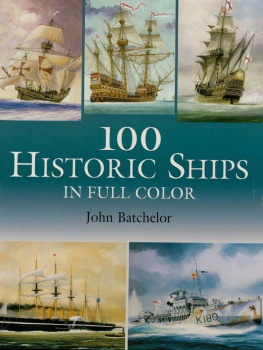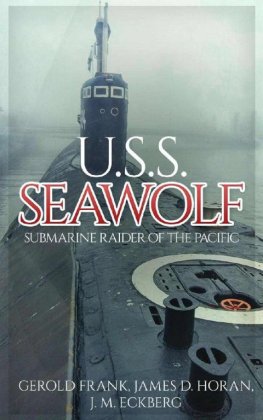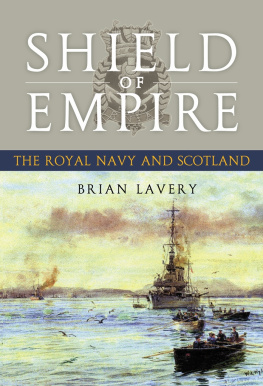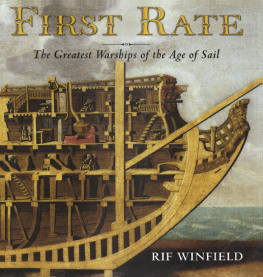John Batchelor - 10 Apr
Here you can read online John Batchelor - 10 Apr full text of the book (entire story) in english for free. Download pdf and epub, get meaning, cover and reviews about this ebook. year: 10 Apr 2013, publisher: Dover Publications, genre: History. Description of the work, (preface) as well as reviews are available. Best literature library LitArk.com created for fans of good reading and offers a wide selection of genres:
Romance novel
Science fiction
Adventure
Detective
Science
History
Home and family
Prose
Art
Politics
Computer
Non-fiction
Religion
Business
Children
Humor
Choose a favorite category and find really read worthwhile books. Enjoy immersion in the world of imagination, feel the emotions of the characters or learn something new for yourself, make an fascinating discovery.
- Book:10 Apr
- Author:
- Publisher:Dover Publications
- Genre:
- Year:10 Apr 2013
- Rating:3 / 5
- Favourites:Add to favourites
- Your mark:
- 60
- 1
- 2
- 3
- 4
- 5
10 Apr: summary, description and annotation
We offer to read an annotation, description, summary or preface (depends on what the author of the book "10 Apr" wrote himself). If you haven't found the necessary information about the book — write in the comments, we will try to find it.
10 Apr — read online for free the complete book (whole text) full work
Below is the text of the book, divided by pages. System saving the place of the last page read, allows you to conveniently read the book "10 Apr" online for free, without having to search again every time where you left off. Put a bookmark, and you can go to the page where you finished reading at any time.
Font size:
Interval:
Bookmark:
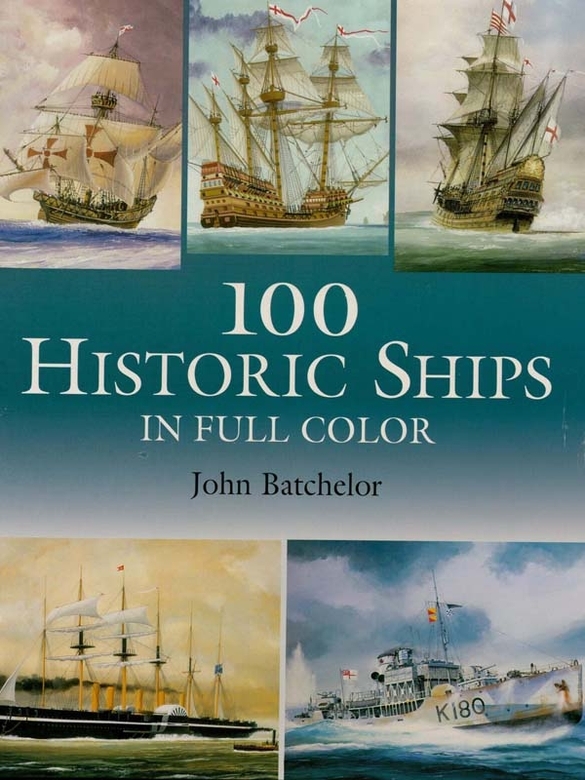
The author wishes to thank Malcolm Lowe for his invaluable help with the text;
Joslyn Pine at Dover Publications who never hesitates to go the extra mile for quality;
and Dovers super design teamFrank Fontana, Marie Zaczkiewicz, Irene Kupferman,
Beverly McKinley Wynne, and Fred Becker.
JOHN BATCHELOR ILLUSTRATION: www.publishingsolutionswww.com
JOHN BATCHELOR has been drawing aircraft, ships, tanks, and all things technical since he was four years of ageat least; his drawings collected by his mother during World War II prove this to be so. On being refused entry to art school, Mr. Batchelor went off and worked his way around the world, drawing many details of the ships he worked and traveled on. At eighteen years, he joined the RAF for his national service, filling further sketchpads in the process.
In January 2000, John Batchelor marked his fortieth year as a freelance technical artist, working for many international publishers and specializing in cutaway illustrations. He also produces postage stamps for thirty-eight countries. Mr. Batchelor is a light aircraft pilot and fanatical fly fishermancasting his flies in many countries. He is also a collector of proper jazz, and he carries a sketchbook wherever he goes. Apart from drawing, he is happiest driving tanks, and flying in any type of aircraft, going to sea in any type of ship, firing guns of all sorts, all of which comes within the remit of being a technical artist.
The first craft with sails Mr. Batchelor ever set foot on was a Thames spritsail barge during World War II. When he was seventeen he worked his way around the British Isles as the lowest form of life on a 1920s coaster just for the experience. He has sailed a felucca on the Nile; been to sea on at least a dozen warships of various countries; was flown aboard the U.S.S. Abraham Lincoln in the Pacific, and was catapulted off four days later. He has spent many, many days on board ships such as the H.M.S. Victory, U.S.S. Constitution , Cutty Sark , and the whaler Charles W Morgan , drawing details for some of the cutaways produced here.
Take it all in all, a ship is the most honourable thing a man has ever produced.
John Ruskin
I T IS LIKELY that early human beings first ventured into the water to catch fish close to shore, and probably climbed onto passing logs only for sport. The accidental use of logs or tree trunks as a means of water transport may thus have been the starting point in the evolution of the ship. The civilizations that emerged along the coast of the Mediterranean and neighboring waters produced the first vessels that could truly be called ships. As with aviation, there were two approaches to their development: ships for trade and ships for war. For thousands of years, this mode of transportation received more attention than any other, so it is not surprising that so much ingenuity and technical skill were invested in the production of bigger, better, and safer ships.
Until little more than 125 years ago, the sailing ship reigned supreme, and required elaborate and specialized skills that few sailors today possess. However, the invention of the steam engine during the Industrial Revolution enabled the creation of ships that could move against the wind. Other innovations followed, such as larger and more powerful guns that led, in turn, to heavy armored ships designed to withstand the impact of those guns. By the dawn of the twentieth century, new technologies made it possible to begin to explore the depths of the sea, and a whole new field of underwater exploration was born. Aircraftthe newcomers to the realm of transportationhave made the greatest advances in the last century. Yet after more than 60,000 years, ships endure not only in trade, exploration, and defense, but also as an essential element in mans eternal romance with the sea.
John Batchelor
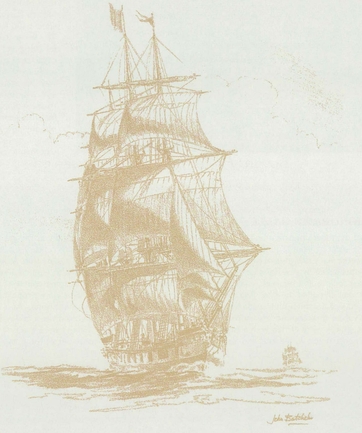

1. KING KHUFUS SHIP
The oldest known vessel in existence is an Egyptian royal barge of King Khufu (known to the Greeks as Cheops). Dating from around 2657 B.C., it was found sealed in a pit at the foot of the Great Pyramid at Giza in 1954. Fashioned from Lebanese cedar wood, the craft was built from the outside inin the tradition of the timeinstead of by the modern method of first laying a keel, and building a strong framework onto which the outer structure is later attached. The Egyptians built Khufus barge by fastening the wood planks of the hull together, and then strengthening the structure with internal ribs, the whole assembly being tied together with alfa grass rope. The barge was 144 feet long, and the large structure on the deck at the stern was a stateroom for the deceased pharaoh. Scholars differ as to the original purpose of the boat. Some believe that it was intended as a solar boat to carry Khufus spirit as it accompanied the sun-god Ra on his eternal journey across the heavens; while others believe it was a funerary barge that actually transported Khufus body down the Nile from Memphis, the pharaohs capital city, to Giza, the royal necropolis. After its excavation in the early 1950s, the ship was restored over a period of many years, and is now on view at the Khufu Ship Museum at Giza.
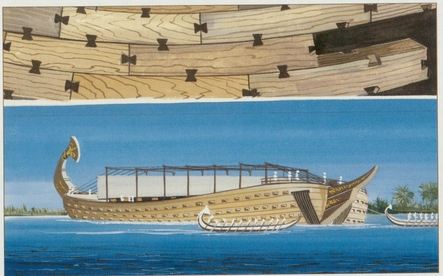
2. QUEEN HATSHEPSUTS SHIP
The first great woman ruler in history was Queen Hatshepsut, a leader of ancient Egypt circa 1500 B.C. During her reign, waterborne commerce flourished in and around the Nile, and spread to other areas of the ancient Middle East. Single-sail seagoing merchant ships, some around ninety feet in length, were constructed from wood and used for this burgeoning trade. Grandest of all was Queen Hatshepsuts huge cargo barge that was used to transport two massive rock obelisks from a quarry at Aswan down the river Nile to Karnak. Each of these stone blocks was almost 100 feet long, and weighed about 350 tons. The barge itself was a massive ship approximately 200 feet long and 70 feet wide, with a fully loaded capacity of approximately 1,500 tons. The vessel was made from small wooden blocks pegged together with hourglass-shaped pieces of wood (as shown), with a system of stretched ropes running from bow to stern above the deck to strengthen its keel-less hull. It is generally believed that the great ship, without any power source of its own, had to be towed along by twenty-seven smaller craft rowed by thirty oarsmen in each boat.
3. MONOREME GALLEY
One of the most important and widely used types of ship in the ancient world was the galley. Originally dating from around 3000 B.C. and surviving well into the eighteenth century A.D., the galley underwent many design modifications, and served as both a warship and a trading ship. Although mainly propelled by rows of oarsmen, some of these wooden vessels were also equipped with masts and sails for use in a favorable wind. The oarsmen were often slaves, but in some countries professional seamen pulled the oars. The simplest and earliest forms of galley ships were propelled by a single row of oarsmen on a single level; these were sometimes known as monoremes. At a later stage, they evolved to accommodate more oarsmen arranged in banks or benches on several levels. In times of war, galleys were armed with a large ram extending from the bow. Galleys were the first watercraft to be constructed with a keel and internal structure, a practice that continues to the present day.
Font size:
Interval:
Bookmark:
Similar books «10 Apr»
Look at similar books to 10 Apr. We have selected literature similar in name and meaning in the hope of providing readers with more options to find new, interesting, not yet read works.
Discussion, reviews of the book 10 Apr and just readers' own opinions. Leave your comments, write what you think about the work, its meaning or the main characters. Specify what exactly you liked and what you didn't like, and why you think so.

